The Armed Forces published an official video demonstrating the Osa air defence system equipped with new missiles. It successfully destroys enemy drones, in particular.
Points of attention
- The Armed Forces published a video demonstrating the updated Osa air defence system with new missiles.
- The R-73 missile on the Osa air defence system has promising characteristics: a range of 12 kilometres, lighter weight and a more powerful warhead.
- The R-73's infrared homing head makes it more effective against cruise missiles and other targets, distinguishing it from the 9M33 radio-controlled missile.
- Integrating the R-73 into the Osa air defence system allows it to combat naval drones, making them the first maritime unmanned air defence systems.
AFU showed the updated 'Osa' air defence system
The following video was shot by the 1129th Anti-Aircraft Missile Regiment from Bila Tserkva and was distributed by the "North" Operational Command "North".
The video shows how the "Osa" system successfully destroys an enemy reconnaissance drone with the help of a regular 9M33 missile that uses a radio command guidance system.
However, more significant is the presence of the R-73 air-to-air missile launcher on the other side. It is the first official video showing the R-73 missile on the 'Osa' air defence system, although unofficial photos of such a combination have been circulating online for a long time.
The R-73 is promising for anti-aircraft systems, as it has a range of up to 12 kilometres, which exceeds the capabilities of the 9M33 — 10 kilometres.
What are the characteristics of the "Osa" air defence system
In addition, R-73 has the following characteristics:
it is lighter — 105 kilograms against 128 kilograms;
has a more powerful warhead — 15 kilograms against 8 kilograms.
The main difference between these missiles is the guidance system:
9M33 is controlled by radio command;
The P-73 has an infrared homing head.
This makes the 9M33 more effective against drones, while the P-73 is better suited to combat cruise missiles and other targets.
The P-73 is also integrated into Magura V5 naval drones, making them the first unmanned air defence systems. The missile's compact dimensions and the capabilities of the MK-80 homing head, which has a field of view of 75 degrees, make this decision logical.
Naval drones use thermal imaging cameras to detect targets, but operators must aim the missile at the target and wait for it to be captured by the homing head. A similar process occurs when launching the R-73 from the Osa air defence system.
Integrating the R-73 into the "Osa" air defence system is similar to combining the AIM-9 missile with an infrared homing head. It is worth noting that the USA officially announced the transfer of AIM-9M to the Armed Forces for the FrankenSAM project, which expands the capabilities of Ukrainian air defence.




